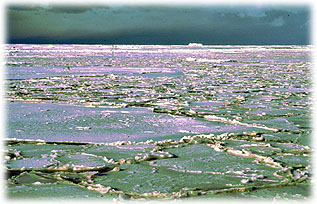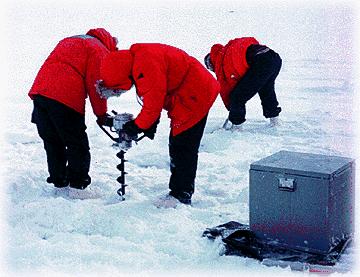
Hello. My name is Martin Jeffries. I am a glaciologist who studies sea
ice thickness and formation in Antarctica. I'm interested in the
interaction between the air, the sea ice, and the ocean. Sea ice plays an
important role in the exchange of energy between the ocean and atmosphere
(and vice versa) and it has a significant impact on regional and global
climate change.

Sea ice freezes from sea water and grows to cover large areas of polar
oceans during winter. It mostly melts away again each summer. Photograph by
S. Shipp, Rice University.
Before I Became a Scientist
As a teenager, I played soccer and cricket and collected stamps. I enjoyed
geography and history; I didn't like physics, chemistry, or mathematics.
I've found that physics and mathematics are essential to the study of sea
ice and their use is unavoidable; I certainly have had to draw on them
often throughout my career. I no longer dislike the subjects as much as I
did, although sometimes I am surprised I ended up a scientist.
How I Became a Glaciologist
I became interested in glaciology as an undergraduate at the University of
Sheffield, England, where one of the most interesting classes I took was
entitled "Glaciers and Landscape." After graduation from the University of
Sheffield I worked as a research assistant on a project on ice caps on the
Arctic Circle in Norway where I became even more interested in glacier
studies, and in studying overseas. I went to graduate school at the
University of Calgary, Canada, expecting to study glacier hydrology in the
Rocky Mountains. However, good luck led me to northernmost Ellesmere
Island on the Arctic Ocean way up north in Canada to study ancient (3000
year) and multiyear sea ice. I have been studying sea ice and lake ice
ever since. I now work at the Geophysical Institute of Alaska.
What I'm Studying Now
A few topics I am investigating right now are the variation of sea ice
thickness and snow depth across space and time and the changes in heat and
salt content in sea water and ice when sea ice forms and thickens. I also
study the formation of snow ice from flooding of ice floes, the motion of
sea ice, and the changing shape of the sea ice surface.

Drilling through the sea ice. Photograph courtesy of Charlotte Kelchner,
Rice University.
Much of what is compelling about this research is related to the excitement
and privilege of being able to work in remote Antarctic waters where so few
people are able to visit. So much is new and much remains to be learned
and understood in Antarctica. The sense of privilege of being able to
study there, and with funding from the National Science Foundation, can not
be exaggerated.
What I Do When I'm Not Floating on Sea Ice in the Polar Ocean
I enjoy reading, stamp collecting (including stamps of the polar regions),
and walking or hiking.
Back to Marge Porter's page
|
